
AVALIAÇÃO DA POTENCIALIDADE DE RESÍDUOS GERADOS PELA INDÚSTRIA DE PAPEL E CELULOSE COMO MATERIAIS ALTERNATIVOS PARA A INDÚSTRIA CIMENTEIRA
O aumento da atividade industrial
conduz a um maior consumo de recursos
naturais e consequentemente maior geração
de resíduos. Portanto, estudos que tendem a
valorização destes subprodutos têm atraído
cada vez mais interesse. Este trabalho objetiva
apresentar uma visão geral da possibilidade
da utilização de três resíduos gerados no
processo para obtenção da celulose: Os grits,
as cinzas volantes e o lodo de estação de
tratamento de efluente, como matérias-primas
alternativas, caracterizando-os através de
análises físico-químicas e também em relação
a sua periculosidade quanto a norma ABNT
NBR 10004:2004, visando a incorporação
dos mesmos em processos para obtenção de
materiais cimentícios. A análise de Fluorescência
de Raio – X, mostrou a predominância de
carbonato de cálcio (51,10%), sílica (43,63%)
e perda ao fogo (74,47%) para grits, cinzas
volantes e lodo de estação de tratamento de
efluentes, respectivamente. Os difratogramas
de raios X, identificaram fases calcita e quartzo
para ambos os resíduos. A análise térmica
mostrou pico endotérmico (745ºC) para o
grits, referente a descarbonatação e picos
exotérmicos (359 °C e 434 ºC) para o lodo de
estação de tratamento de efluente, possibilitando
a utilização deste material como combustível
alternativo no processo de clinquerização. Os
resultados referentes a umidade para grits, cinza
volantes e lodo de estação de tratamento são
de 13,43%, 21,65 % e 87% respectivamente.
Deste modo, as conclusões apontam os
resíduos como materiais alternativos com
potencial para a obtenção de clínqueres, pois
suas características são semelhantes com as
das matérias-primas usualmente utilizadas nas
cimenteiras.
AVALIAÇÃO DA POTENCIALIDADE DE RESÍDUOS GERADOS PELA INDÚSTRIA DE PAPEL E CELULOSE COMO MATERIAIS ALTERNATIVOS PARA A INDÚSTRIA CIMENTEIRA
-
DOI: 10.22533/at.ed.88619140313
-
Palavras-chave: Resíduos,Potencialidade, Materiais cimentícios.
-
Keywords: Wastes, Potentiality, Cementitious materials.
-
Abstract:
The increase of industrial activity leads to a higher consumption of
natural resources and, consequently, a larger generation of waste. Therefore, studies
that tend to value these by-products have attracted a greater interest. Hence, this
paper presents an overview of the possibility of using three residues from the pulping
process: grits, fly ash and effluent treatment sludge as an alternative raw material,
characterizing them through physical-chemical analysis and also in relation to their
dangerousness according to the norm ABNT NBR 10004:2004, aiming to incorporate
the same in processes to obtain cementitious materials. The x- ray fluorescence
analysis showed the predominance of calcium carbonate (51.10%), silica (43.63%) and
loss on ignition (74.47%) for grits, fly ash and effluent treatment sludge, respectively.
The x-ray diffraction identified calcite and quartz phases for both residues. The thermal
analysis showed endothermic peak (745ºC) for the grits, referring to decarbonation
and exothermic peaks (359 °C and 434 ºC) in effluent treatment sludge, making it
possible to use this material as an alternative fuel in the clinkering process. The results
for the humidity to grits, fly ash and effluent treatment sludge are 13.43%, 21.65% and
87% respectively. Thus, the conclusions point out the residues as potential alternative
materials to obtain clinkers, once their characteristics are similar to those of the raw
materials usually used in cement plants.
-
Número de páginas: 15
- Letícia Torres Maia
- Oscar Rubem Klegues Montedo
- Dachamir Hotza
- Hiany Mehl Zanlorenzi
- Silvana Meister Sommer
- Joana Gomes Meller


